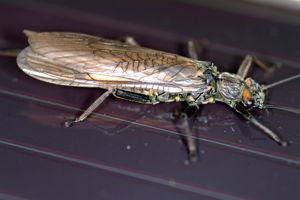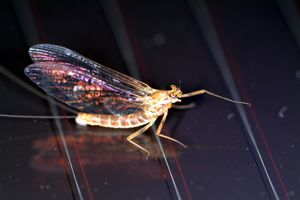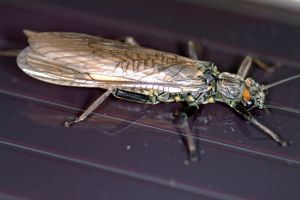Science Note/Aquatic Insects and Solar Panels
Air Date: Week of July 9, 2010

A stonefly rests on a solar panel, confusing it with it's usual resting spot- water. (Photo: Gyorgy Kriska)
Researchers have observed some aquatic insects laying their eggs on solar panels instead of in water. As Living on Earth’s Meghan Miner reports, this could lead to a decrease in insect populations where solar panels are prevalent.
Transcript
YOUNG: It’s Living on Earth, I’m Jeff Young. Just ahead – enlisting a tiny insect to fight a wooly bully –but first - this note on emerging science from Meghan Miner.
[THEME]
MINER: Imagine stepping into a pristine swimming pool. But instead of the cool, refreshing dip you were expecting, your feet rest on a sheet of glass. Researchers have found that some aquatic insects are having a difficult time finding their swimming pools and are landing on solar panels instead!
Scientists at Michigan State University and in Hungary have discovered that mayflies, stoneflies and other aquatic insects become mesmerized by solar panels- buzzing around and even laying their eggs on them.

A mayfly rests on a solar panel. Increasingly, mayflies and other aquatic insects are attracted to shiny objects like solar panels because of how they polarize light. (Photo: Gyorgy Kriska)
The bugs use polarized light to find water- but there are some shiny objects that can actually polarize light better than water. Solar panels polarize 100% of the light that hits them, while water can only polarize 60% of light. Solar panels may be enough of a distraction to decrease insect populations in some areas. And, because water insects like mayflies, are part of the aquatic food chain, a reduction in their numbers could spell problems for entire ecosystems in the future.

A stonefly rests on a solar panel, confusing it with it's usual resting spot- water. (Photo: Gyorgy Kriska)
But the researchers have found a way to combat this bug bewilderment. They’ve added strips of white tape to break up the solar panel into small squares: the smaller areas look like tiny bodies of water, and become less appealing places for bugs to land and settle down. So, the next time you find yourself lounging by the pool, be thankful you didn’t have to use polarization to find it! That’s this week’s note on Emerging Science. I’m Meghan Miner.
Links
Living on Earth wants to hear from you!
Living on Earth
62 Calef Highway, Suite 212
Lee, NH 03861
Telephone: 617-287-4121
E-mail: comments@loe.org
Newsletter [Click here]
Donate to Living on Earth!
Living on Earth is an independent media program and relies entirely on contributions from listeners and institutions supporting public service. Please donate now to preserve an independent environmental voice.
NewsletterLiving on Earth offers a weekly delivery of the show's rundown to your mailbox. Sign up for our newsletter today!
 Sailors For The Sea: Be the change you want to sea.
Sailors For The Sea: Be the change you want to sea.
 The Grantham Foundation for the Protection of the Environment: Committed to protecting and improving the health of the global environment.
The Grantham Foundation for the Protection of the Environment: Committed to protecting and improving the health of the global environment.
 Contribute to Living on Earth and receive, as our gift to you, an archival print of one of Mark Seth Lender's extraordinary wildlife photographs. Follow the link to see Mark's current collection of photographs.
Contribute to Living on Earth and receive, as our gift to you, an archival print of one of Mark Seth Lender's extraordinary wildlife photographs. Follow the link to see Mark's current collection of photographs.
 Buy a signed copy of Mark Seth Lender's book Smeagull the Seagull & support Living on Earth
Buy a signed copy of Mark Seth Lender's book Smeagull the Seagull & support Living on Earth

